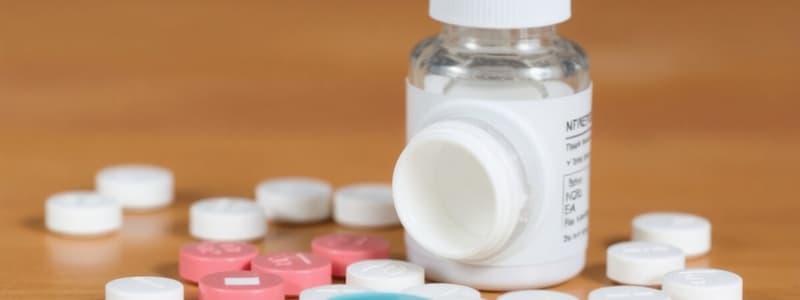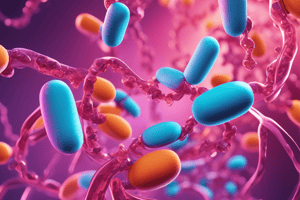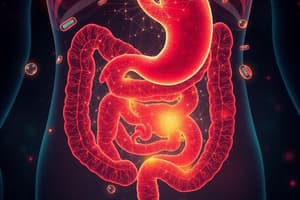Podcast
Questions and Answers
Which antibiotic was the first approved by the FDA specifically for treating traveler’s diarrhea?
Which antibiotic was the first approved by the FDA specifically for treating traveler’s diarrhea?
- Alosetron
- Eluxadoline
- Rifaximin (correct)
- Crofelemer
For which condition is Alosetron indicated?
For which condition is Alosetron indicated?
- Severe diarrhea-prominent IBS (correct)
- Chronic constipation
- Traveler’s diarrhea
- Non-invasive E. coli infection
What is the mechanism of action of Lubiprostone?
What is the mechanism of action of Lubiprostone?
- Mu-opioid receptor agonist
- Selective serotonin type 4 receptor agonist
- Chloride channel activator (correct)
- Serotonin 5-HT antagonist
Which medication is primarily used for chronic constipation?
Which medication is primarily used for chronic constipation?
Which adverse effect is specifically associated with Alosetron?
Which adverse effect is specifically associated with Alosetron?
Which agent acts as a mu-opioid receptor agonist for treating IBS?
Which agent acts as a mu-opioid receptor agonist for treating IBS?
What is the main concern when using antidepressants in patients taking Prucalopride?
What is the main concern when using antidepressants in patients taking Prucalopride?
What should be considered a contraindication for most IBS medications?
What should be considered a contraindication for most IBS medications?
For which scenario is Tegaserod indicated?
For which scenario is Tegaserod indicated?
Why are laxatives recommended for short-term use only?
Why are laxatives recommended for short-term use only?
What is one of the main actions of drugs affecting gastrointestinal motility?
What is one of the main actions of drugs affecting gastrointestinal motility?
Which type of laxative works by chemically irritating the lining of the GI tract?
Which type of laxative works by chemically irritating the lining of the GI tract?
Which of the following laxatives is contraindicated during pregnancy?
Which of the following laxatives is contraindicated during pregnancy?
What is the primary therapeutic action of bulk-forming laxatives?
What is the primary therapeutic action of bulk-forming laxatives?
What is a common side effect of stimulant laxatives?
What is a common side effect of stimulant laxatives?
Which drug type is indicated for the treatment of fecal impaction?
Which drug type is indicated for the treatment of fecal impaction?
What potential issue can arise from overusing laxatives?
What potential issue can arise from overusing laxatives?
Which of the following laxatives acts similarly to dietary fiber?
Which of the following laxatives acts similarly to dietary fiber?
What is the indication for using osmotic laxatives?
What is the indication for using osmotic laxatives?
Which of the following is a potential adverse effect of osmotic laxatives?
Which of the following is a potential adverse effect of osmotic laxatives?
What is the primary function of lubricants in laxatives?
What is the primary function of lubricants in laxatives?
Which of the following laxatives is contraindicated in acute abdominal disorders?
Which of the following laxatives is contraindicated in acute abdominal disorders?
What caution should be taken when using magnesium-based laxatives?
What caution should be taken when using magnesium-based laxatives?
Which laxative type is indicated as an adjunct for anthelmintic activity?
Which laxative type is indicated as an adjunct for anthelmintic activity?
Which medication is specifically indicated for the treatment of chronic idiopathic constipation?
Which medication is specifically indicated for the treatment of chronic idiopathic constipation?
What is the primary action of Docusate as a lubricant laxative?
What is the primary action of Docusate as a lubricant laxative?
Which of the following medications is NOT an opioid agonist for treating constipation?
Which of the following medications is NOT an opioid agonist for treating constipation?
What is the primary therapeutic action of Metoclopramide?
What is the primary therapeutic action of Metoclopramide?
Which adverse effect is most likely associated with the use of lubricants like Mineral Oil?
Which adverse effect is most likely associated with the use of lubricants like Mineral Oil?
What is a common contraindication for using opioid agonists for constipation?
What is a common contraindication for using opioid agonists for constipation?
Which medication blocks the action of opioids on the GI tract?
Which medication blocks the action of opioids on the GI tract?
What is a boxed warning associated with Metoclopramide?
What is a boxed warning associated with Metoclopramide?
Which of the following ingredients in Antidiarrheals works through direct action on the lining of the GI tract?
Which of the following ingredients in Antidiarrheals works through direct action on the lining of the GI tract?
What should be monitored in patients taking opioid agonists for constipation?
What should be monitored in patients taking opioid agonists for constipation?
What is the role of Glycerin as a lubricant laxative?
What is the role of Glycerin as a lubricant laxative?
Which of the following drugs would be contraindicated in a patient with GI obstruction?
Which of the following drugs would be contraindicated in a patient with GI obstruction?
What is a therapeutic use of Loperamide as an antidiarrheal?
What is a therapeutic use of Loperamide as an antidiarrheal?
Which laxative is known for interfering with the absorption of fat-soluble vitamins?
Which laxative is known for interfering with the absorption of fat-soluble vitamins?
Flashcards are hidden until you start studying
Study Notes
Actions of Drugs Affecting GI Motility
- Speed up or improve movement of intestinal contents along the GI tract when movement becomes slow or sluggish to allow for proper excretion of wastes (constipation)
- Increase the tone of the GI tract and stimulate motility throughout the system
- Decrease movement along the GI tract when rapid movement decreases the time for absorption of nutrients (diarrhea)
Sites of Action of Drugs Affecting GI Motility
- Drugs can affect GI motility by acting on a multitude of different sites:
- Nerve plexus
- Smooth muscle
- Neurotransmitters
- Membrane receptors
Use of Laxative and Antidiarrheal Agents Across the Lifespan
- Use of laxatives and antidiarrheal agents is increasingly common across the lifespan as modern lifestyles and diet can contribute to digestive issues.
- Children may require special considerations due to their smaller size and different needs, but as they grow older, it's important to address the root causes behind these complications.
- Many older adults experience age-related changes in their digestion, making them more susceptible to constipation and other digestive issues. It's crucial to ensure appropriate usage of these drugs in this age group.
- Understanding the potential risks and benefits of both laxatives and antidiarrheal agents in different life stages is essential for safe and effective treatment.
Laxatives
- Indicated for short-term relief of constipation to prevent straining, to evacuate bowel for diagnostic procedures, to remove ingested poisons, and as an adjunct for anthelmintic activity
- Most available as over-the-counter preparations
- Have the potential for overuse and dependency
Kinds of Laxatives
- Stimulants: chemically irritate the lining of the GI tract
- Bulk-forming agents: cause fecal matter to increase in bulk
- Osmotic: pull more solute and/or water into the GI tract
- Lubricants: help intestinal contents stay softer, more slippery
- Newer laxatives: available for specific needs; alter sodium absorption or affect opioid receptors in the GI tract
Chemical Stimulants
- Directly stimulate nerve plexus, causing increased movement and stimulation of local reflexes
- Drugs: Bisacodyl (Dulcolax), Castor oil (generic), Senna (Senokot)
- Therapeutic actions:
- Begin working at the beginning of the small intestine
- Increase motility throughout the rest of the GI tract by stimulating the nerve plexus
- Castor oil blocks absorption of fats
- Indications: Short-term treatment of constipation
- Pharmacokinetics: Most of these agents are only minimally absorbed and exert their therapeutic effects directly in the GI tract
Chemical Stimulants
- Contraindications: Allergy, acute abdominal disorders, castor oil: pregnancy
- Caution: Heart block, CAD, debilitation, acute abdominal pain, nausea or vomiting, pregnancy and lactation
- Adverse effects:
- GI: diarrhea, abdominal cramping, nausea
- CNS: dizziness, headache, weakness
- Sweating, palpitations, flushing, fainting
- Cathartic dependence
- Castor oil: blocks absorption of fats (including fat-soluble vitamins) and may lead to malnutrition
- Drug–drug interactions: Other prescribed medications
Bulk-Forming Laxatives
- Cause fecal matter to increase in bulk
- Increase motility of the GI tract by increasing the size of fecal matter
- Helps pull more fluid in intestinal contents
- Stimulates local stretch receptors and activates local activity
- Drugs: Methylcellulose (Citrucel), Polycarbophil (FiberCon), Psyllium (Metamucil)
Bulk-Forming Laxatives
- Therapeutic actions: Act in a manner similar to dietary fiber
- Indications: Treatment of constipation, decrease diarrhea in patients with diverticulosis or IBS
- Pharmacokinetics: Directly effective within GI tract; not generally absorbed systemically, can act rapidly
Bulk-Forming Laxatives
- Contraindications: Allergy, acute abdominal disorders, acute infections, intestinal obstruction, perforation, rectal bleeding, or healing from acute abdominal surgery
- Adverse effects: GI effects: diarrhea, abdominal cramping, nausea, CNS effects: dizziness, headache, weakness, sweating, palpitations, flushing, fainting, Advise patients to take with plenty of water
- Drug–drug interactions: Other prescribed medications
Osmotic Laxatives
- Have solutes that increase osmotic pull of fluid into GI tract
- Increase pressure in GI tract and stimulate more intestinal motility
- Drugs: Magnesium sulfate (Epsom salts), Magnesium citrate (Citrate of Magnesia), Magnesium hydroxide (Milk of Magnesia), Lactulose (Constilac, Cholac), Lactitol (Pizensy), Polyethylene glycol (MiraLAX), Polyethylene glycol electrolyte solution (GoLYTELY), Sodium picosulfate with magnesium oxide and citric acid (Clenpiq)
- Therapeutic actions: Draw more water into GI tract and stimulate increased GI motility, Specific actions vary by drug
- Indications: Treatment of constipation, other specific indications vary by drug
- Pharmacokinetics: Rates of action vary based on formulation and route of administration
Osmotic Laxatives
- Contraindications: Acute surgical abdomen, fecal impaction, intestinal obstruction, lactulose: appendicitis, cautions: lactulose: diabetes, magnesium: renal insufficiency, polyethylene glycol: history of seizures
- Adverse effects: GI effects: diarrhea, abdominal cramping, abdominal bloating nausea, Dehydration: dry mouth, dizziness light-headedness, CNS effects: dizziness, headache, weakness, sweating, palpitations, flushing, fainting, Suppositories: rectal irritation
- Drug–drug interactions: Other medications, Magnesium salts: neuromuscular junction blockers
Lubricants
- Make defecation easier without stimulating movement of the GI tract
- Benefit patients with hemorrhoids, who have had recent rectal surgery, or who could be harmed by straining
- Choice depends on condition, speed of relief needed, adverse effects
- Drugs: Docusate (Colace), Glycerin (Sani-Supp), Mineral Oil (Agoral)
- Therapeutic actions:
- Docusate: Detergent action on surface of intestinal bolus
- Glycerin: hyperosmolar laxative gently evacuates rectum without systemic effects higher in GI tract
- Mineral oil: forms slippery coating on contents of intestinal tract
- Indications: Short-term treatment of constipation
- Pharmacokinetics: Not absorbed systemically, Excreted in feces
- Contraindications: Allergy
- Cautions : Abdominal disorders, Pregnancy and lactation
Lubricants
- Adverse effects: GI effects: diarrhea, abdominal cramping, nausea, Mineral oil: leakage and staining, CNS effects: dizziness, headache, weakness, Sweating, palpitations, flushing, fainting (less likely with lubricant laxatives than with others)
- Drug–drug interactions: Frequent use of mineral oil can interfere with absorption of the fat-soluble vitamins A, D, E, and K
Opioid Agonists
- May be used to relieve constipation in specific situations
- Drugs: Alvimopan (Entereg), Methylnaltrexone bromide (Relistor), Naloxegol (Movantik), Naldemedine (Symproic)
- Therapeutic actions: Block effects of opioids on the GI tract by selectively binding to peripheral opioid receptors
- Can help maintain normal motility and secretions while patient is on opioid treatment for pain
- Indications: Treatment of opioid-induced constipation, Alvimopan: Hasten time to gastrointestinal recovery following surgeries that include partial bowel resection with primary anastomosis
- Pharmacokinetics: All but alvimopan: metabolized in liver, Alvimopan: mostly changed to metabolites in GI tract, Eliminated partially by kidneys and partially in feces
- Contraindications: Bowel obstruction, More than 15 doses of alvimopan
- Cautions: Hepatic or renal impairment, Pregnancy and lactation
Opioid Agonists
- Adverse effects: Abdominal pain, diarrhea, nausea, vomiting, dizziness, flatulence, headache, Monitor patients for opioid withdrawal symptoms, Monitor for GI perforation if abdominal pain is severe
- Drug–drug interactions: Other opioid antagonists, Naloxegol and naldemedine with CYP3A inducers or CYP3A4 inhibitors
Gastrointestinal Stimulant
- More generalized GI stimulation resulting in overall increase in GI activity and secretions
- Stimulate parasympathetic activity or make GI tissues more sensitive to parasympathetic activity
- Drug: Metoclopramide (Reglan)
- Therapeutic actions:
- Stimulates parasympathetic activity within the GI tract
- Increases GI secretions and motility
- Blocks dopamine receptors and makes GI cells more sensitive to acetylcholine
- Leads to increased GI activity and rapid movement of food through the upper GI tract
- Stimulates parasympathetic activity within the GI tract
- Indications: When rapid movement of GI contents is desirable
- Pharmacokinetics: Rapidly absorbed, Metabolized in the liver; excreted in feces and urine, Crosses placenta and enters human milk
- Contraindications: Allergy, GI obstruction or perforation
- Cautions: Pregnancy and lactation, History of tardive dyskinesia, seizures, or depression
Gastrointestinal Stimulant
- Adverse effects: Nausea, vomiting, diarrhea, intestinal spasms, cramping, Declining blood pressure and heart rate, weakness, and fatigue, Boxed warning: tardive dyskinesia
- Drug–drug interactions: Alcohol or other CNS sedative drugs, Antipsychotic medications, MAOIs, Strong CYP2D6 inhibitors
Antidiarrheals
- Block stimulation of the GI tract for symptomatic relief from diarrhea
- Drugs: Bismuth subsalicylate (Pepto-Bismol), Crofelemer (Mytesi), Loperamide (Imodium A-D), Opium derivatives (Paregoric), Some anticholinergic medications, Several available in combination
- Therapeutic actions:
- Slow motility of the GI tract
- Bismuth subsalicylate: Direct action on the lining of the GI tract
- Loperamide: Direct action on muscles of the GI tract
- Opium derivatives: Action on CNS centers to cause GI spasm and slowing
- Crofelemer: Blocks specific chloride channels leading to less water loss as diarrhea
- Slow motility of the GI tract
Antidiarrheals
- Indications: Relief of symptoms of acute and chronic diarrhea, Reduction of volume of discharge from ileostomies, Prevention and treatment of traveler’s diarrhea, Bismuth subsalicylate: Diarrhea and GI symptoms associated with dietary excess, some viral infections, Crofelemer: Symptomatic relief of noninfectious diarrhea in adult patients on HIV/AIDS antiretrovirals
- Pharmacokinetics: Vary depending on agent
- Contraindications: Allergy
- Cautions: Pregnancy and lactation, History of GI obstruction, Acute abdominal conditions, Diarrhea due to poisonings, Hepatic impairment
Antidiarrheals
- Adverse effects: Related to effects on the GI tract: constipation, distension, abdominal discomfort, nausea, vomiting, dry mouth, toxic megacolon, Other effects: fatigue, weakness, dizziness, skin rash, Opium derivatives: light-headedness, sedation, euphoria, hallucinations, respirator depression
- Drug–drug interactions: Vary depending on agent
IBS and Chronic Constipation Drugs
- IBS affects three times as many females as males
- Reportedly accounts for half of referrals to GI specialists
- Characterized by abdominal distress, bouts of diarrhea or constipation, bloating, nausea, flatulence, headache, fatigue, depression, anxiety
- Underlying causes may be stress and/or dysregulation of the autonomic nervous system
- Drugs to treat IBS: Alosetron (Lotronex), Eluxadoline (Viberzi), Linaclotide (Linzess), Lubiprostone (Amitiza), Plecanatide (Trulance), Tegaserod (Zelnorm), Hyoscyamine, Drug to treat chronic constipation: Prucalopride (Motegrity)
IBS and Chronic Constipation Drugs
- Therapeutic actions and indications:
- Alosetron:
- Serotonin 5-HT antagonist
- Severe diarrhea-prominent IBS
- Eluxadoline:
- Mu-opioid receptor agonist
- Adults with IBS with diarrhea
- Lubiprostone:
- Locally acting chloride channel activator
- Chronic, idiopathic constipation, opioid-induced constipation, IBS with constipation in adult females
- Prucalopride and tegaserod:
- Selective serotonin type 4 receptor agonists
- Chronic constipation
- Tegaserod: Females younger than 65 who suffer from constipation due to IBS
- Linaclotide and plecanatide:
- Guanylate cyclase-C agonists
- Chronic constipation and constipation type IBS
- Alosetron:
IBS and Chronic Constipation Drugs
- Pharmacokinetics: Most are absorbed quickly, Location and extent of metabolism varies
- Contraindications: Allergy, Mechanical gastrointestinal obstruction, Other contraindications vary by agent
- Cautions: Pregnancy and lactation
IBS and Chronic Constipation Drugs
- Adverse effects: GI symptoms: nausea, abdominal pain, diarrhea, constipation, Alosetron: ischemic colitis, Eluxadoline: pancreatitis, Prucalopride and tegaserod: new onset of depression and self-harm behaviors
- Drug–drug interactions: Alosetron or eluxadoline: medications that slow GI motility, Alosetron: CYP1A2 inhibitors; fluvoxamine
Why should laxatives be taken only on a short-term basis?
- Laxatives are primarily designed to provide temporary relief from constipation.
- Prolonged use of laxatives can lead to dependence, reduced bowel function, and electrolyte imbalances.
- Overuse also carries potential risks for dehydration and certain health complications.
- If you experience frequent constipation, addressing the underlying causes is essential for long-term bowel health.
Studying That Suits You
Use AI to generate personalized quizzes and flashcards to suit your learning preferences.




